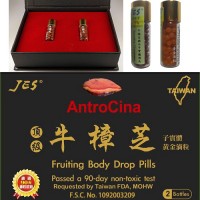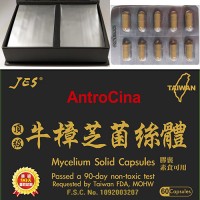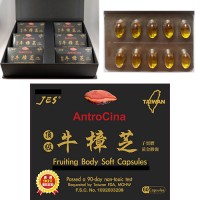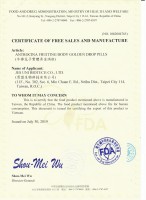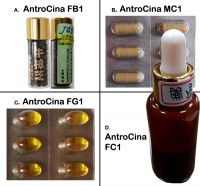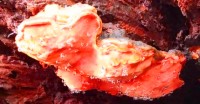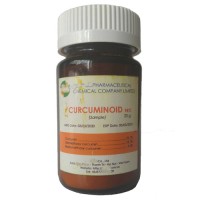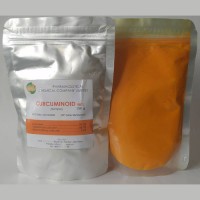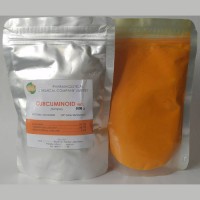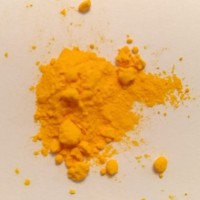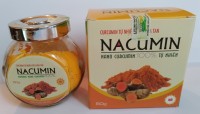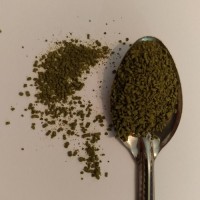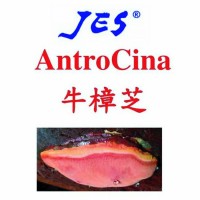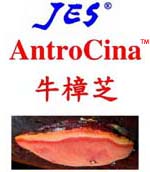AntroCina FD1 牛樟芝子實體滴丸FD1
《Product Content》:
牛樟芝子實體萃取滴丸
AntroCina FD1
DNA品質認證
DNA varified accurate fungus species of
Taiwan Antrodia Camphorata (Antrodia Cinnamomea).
The extraction of fruiting body gifted from the great nature
to help improve human health.
DNA產品驗證
台灣原生牛樟段木生長出來的牛樟芝子實體萃取滴丸
2.5gm 玻璃瓶滴丸。 Filled in 2.5gm glass bottle。
3% triterpenes (總三帖樟芝酸)
(Click), 認識牛樟芝
Taiwanofungus camphoratus (Antrodia cinnamomea)
A new light for chronic diseases
Introducing Taiwanofungus camphoratus
Taiwanofungus camphoratus is a fungus endemic to Taiwan. The fungus forms plate-,bell-, hoof-,
or pagoda-like shaped fruiting bodies. Taiwanofungus camphoratus is perennial and grows specifically
in the tree hollows or the shaded and wet surfaces of the Bull Camphor Tree (Cinnamomum
kanehirae Hayata), which is also endemic to Taiwan. These trees are evergreen broad leaved trees
and grow at an elevation of 200 to 1,500 meters above sea level in the natural environment of
Taiwan. The fruiting body of T. camphoratus is bright red, but becomes pale reddish brown, pale
brown, or pale yellowish brown as it matures. The fungus is also known under its synonyms, such
as Antrodia cinnamomea (the commercial name in Taiwan), Antrodia camphorata, and Ganoderma
camphoratum. All these synonyms have been used in various publications in international journals.
The fungus has also been called the ruby of the forest due to its bright red colors and high prices.
Traditions and history of Taiwanofungus camphoratus
A book named “The General History of Taiwan” includes the following records:
During 1773, pioneers following Wu Sha entered eastern Taiwan to clear land and build new
settlements. Wu Sha had some medical knowledge and was well-versed in the aboriginal languages,
and even took an aboriginal Taiwanese woman as his wife. During his marriage, Wu found that
the aborigines often held a piece of T. camphoratus within their mouths as the fungus repulsed
vile spirits, strengthened the sinews, promoted blood circulation, neutralized poisons,and
bolstered the liver. It turned out that the aborigines of Taiwan accidentally found T. camphoratus
growing in the rotten and hollowed logs of Bull Camphor Trees while hunting in Taiwan’s virgin
forests. Despite its bitter taste, the fungus promoted their appetite and gave no side effects.
The benefits of this fungus spread rapidly after this encounter.
Researches about Taiwanofungus camphoratus
More than 3400 related scientific research reports of T. camphoratus were published in international
journals. Most of them are focused upon cultivation (38%) and extraction (25%) of effective
compounds (20%). We currently know that the fungus contains over 200 types of triterpenes and
polysaccharides. Since the host tree is endemic and endangered, these breakthroughs in artificial
cultivation technologies of T. camphoratus made it easier to collect raw materials and promoted
academic research of this fungus. Recently about 500-600 research papers investigated
the function of T. camphoratus, especially the potential bioactivity against cancer. According to
the traditional usage of this fungus, nearly half of researches follow with interest in hepatic carcinoma (44%).
The way to new drug
Products made from Taiwanofungus camphoratus released on the market also focus on supporting individuals who have received cancer treatments. Several biotech companies are also exploring the potential for liver protection, anti-inflammation, and blood lipid reduction. Both the Taiwanese government and private enterprises have invested large sums of money into this field. Over six large-scale companies also made projects for developing new drugs based on T. camphoratus.
Academicians and researchers in major institutes and colleges as well as in privately operated research agencies are working hard to discover the secrets of T. camphoratus in various aspects ranging from conservation, sustainability, and new drug development. The official scientific research in T. camphoratus began in 1990. More and more published reports increased yearly.
Theo một nghiên cứu được báo cáo bởi Tiến sĩ Shui-Tien Chen, Tiến sĩ Roland Kirschner và Tiến sĩ I-Shu Lee của Hiệp hội:
Taiwanofungus camphoratus (Antrodia cinnamomea)
Một ánh sáng mới cho các bệnh mãn tính (Phần I)
Giới thiệu Taiwanofungus camphoratus
Taiwanofungus camphoratus là loài nấm đặc hữu của Đài Loan. Nấm tạo thành tấm -, chuông -, móng, hoặc các hình dạng quả giống như chùa. Taiwanofungus camphoratus là lâu năm và phát triển đặc biệt trong hốc cây hoặc các bề mặt bóng mờ và ẩm ướt của cây Bull Camphor (Cinnamomum) kanehirae Hayata), cũng là loài đặc hữu của Đài Loan. Những cây này là cây lá rộng thường xanh và phát triển ở độ cao từ 200 đến 1.500 mét trên mực nước biển trong môi trường tự nhiên của Đài Loan. Cơ thể quả của T. camphoratus có màu đỏ tươi, nhưng trở thành màu nâu đỏ nhạt, nhạt nâu, hoặc nâu nhạt màu vàng khi nó trưởng thành. Nấm cũng được biết đến dưới các từ đồng nghĩa của nó, như vậy như Antrodia cinnamomea (tên thương mại ở Đài Loan), Antrodia camphorata và Ganoderma long não. Tất cả các từ đồng nghĩa này đã được sử dụng trong nhiều ấn phẩm khác nhau trên các tạp chí quốc tế. Nấm cũng được gọi là hồng ngọc của rừng do màu đỏ tươi và giá cao.
Truyền thống và lịch sử của Đài Loan campungatus
Một cuốn sách có tên "Lịch sử chung của Đài Loan" bao gồm các hồ sơ sau:
Trong năm 1773, những người tiên phong đi theo Wu Sha vào miền Đông Đài Loan để dọn sạch đất và xây dựng mới khu định cư. Wu Sha có một số kiến thức y khoa và thông thạo ngôn ngữ thổ dân, và thậm chí đã lấy một phụ nữ thổ dân Đài Loan làm vợ. Trong cuộc hôn nhân của mình, Wu thấy rằng thổ dân thường cầm một miếng T. camphoratus trong miệng khi nấm bị đẩy lùi tinh thần hèn hạ, tăng cường các gân, thúc đẩy tuần hoàn máu, các chất độc trung hòa, và ủng hộ gan. Hóa ra là thổ dân Đài Loan vô tình tìm thấy T. camphorates phát triển trong các khúc gỗ thối và rỗng của cây Bull Camphor trong khi săn bắn ở Đài Loan rừng. Mặc dù vị đắng của nó, nấm thúc đẩy sự thèm ăn của họ và không có tác dụng phụ. Những lợi ích của loại nấm này lan truyền nhanh chóng sau cuộc gặp gỡ này.
Nghiên cứu về campongatus Đài Loan
Hơn 3400 báo cáo nghiên cứu khoa học liên quan của T. camphoratus đã được công bố trên phạm vi quốc tế tạp chí. Hầu hết trong số họ tập trung vào canh tác (38%) và khai thác (25%) hiệu quả hợp chất (20%). Hiện tại chúng ta biết rằng nấm có chứa hơn 200 loại triterpen và polysaccharides. Vì cây chủ là loài đặc hữu và có nguy cơ tuyệt chủng, những đột phá này trong nhân tạo công nghệ canh tác của T. camphoratus giúp thu thập nguyên liệu thô và quảng cáo dễ dàng hơn nghiên cứu khoa học của loại nấm này. Gần đây, khoảng 500-600 nghiên cứu đã được nghiên cứu chức năng của T. camphoratus, đặc biệt là khả năng hoạt tính sinh học chống ung thư. Theo việc sử dụng truyền thống của loại nấm này, gần một nửa các nghiên cứu theo quan tâm đến ung thư biểu mô gan (44%).
Cách để dùng thuốc mới
Các sản phẩm được chế biến từ campofatus camphoratus được phát hành trên thị trường cũng tập trung vào việc hỗ trợ những người đã được điều trị ung thư. Một số công ty công nghệ sinh học cũng đang khai thác tiềm năng bảo vệ gan, chống viêm và giảm lipid máu. Cả chính phủ Đài Loan và các doanh nghiệp tư nhân đã đầu tư một khoản tiền lớn vào lĩnh vực này. Hơn sáu công ty quy mô lớn cũng đã thực hiện các dự án phát triển các loại thuốc mới dựa trên T. camphoratus.
Các nhà nghiên cứu và các nhà nghiên cứu tại các viện nghiên cứu và trường đại học lớn cũng như các cơ quan nghiên cứu tư nhân đang nỗ lực tìm hiểu những bí mật của T. camphoratus ở nhiều khía cạnh khác nhau, từ bảo tồn, bền vững và phát triển thuốc mới. Nghiên cứu khoa học chính thức ở T. camphoratus bắt đầu vào năm 1990. Ngày càng có nhiều báo cáo được xuất bản hàng năm
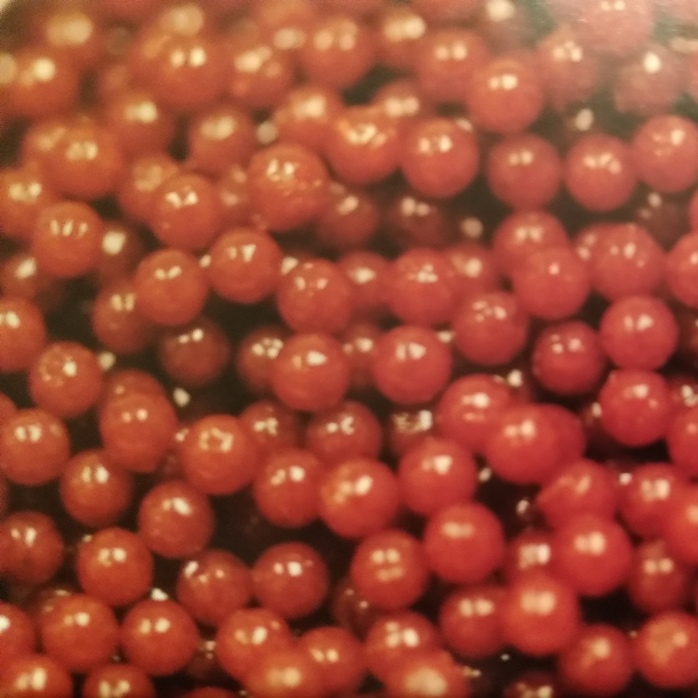

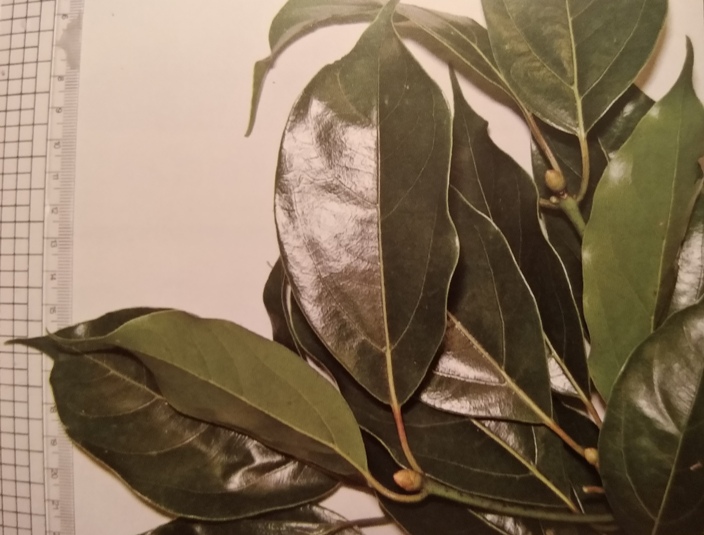
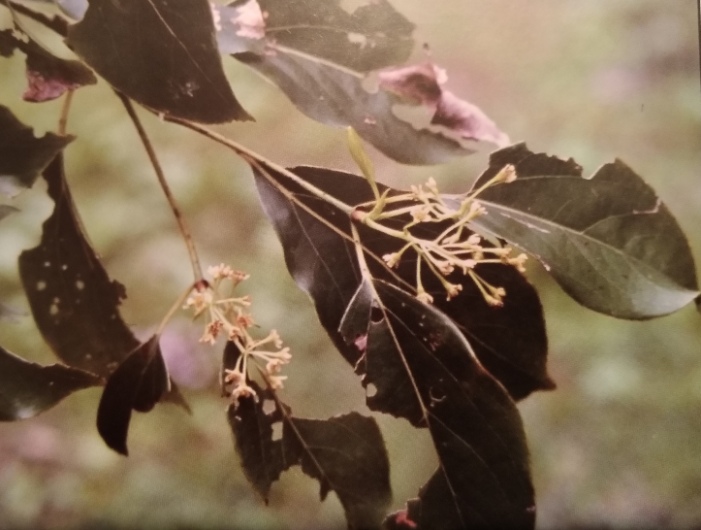



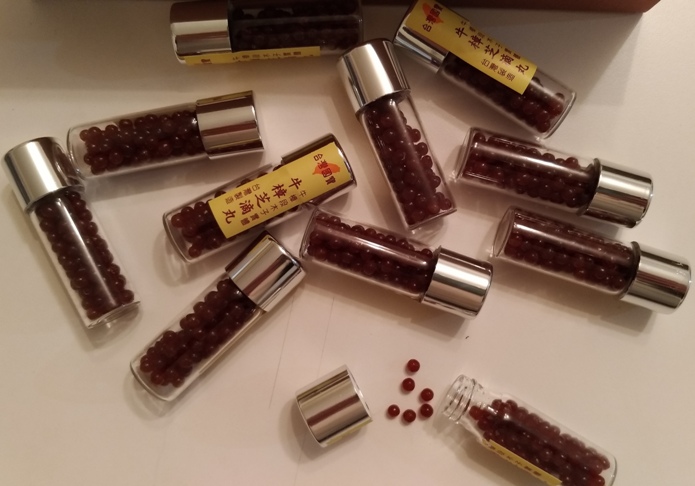
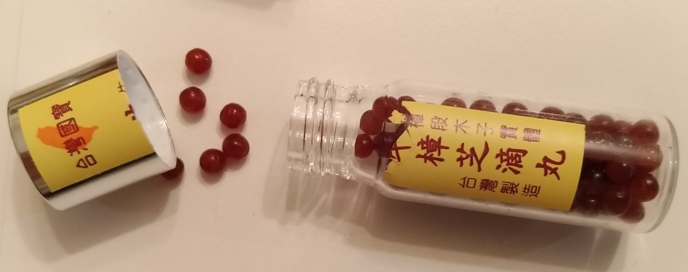
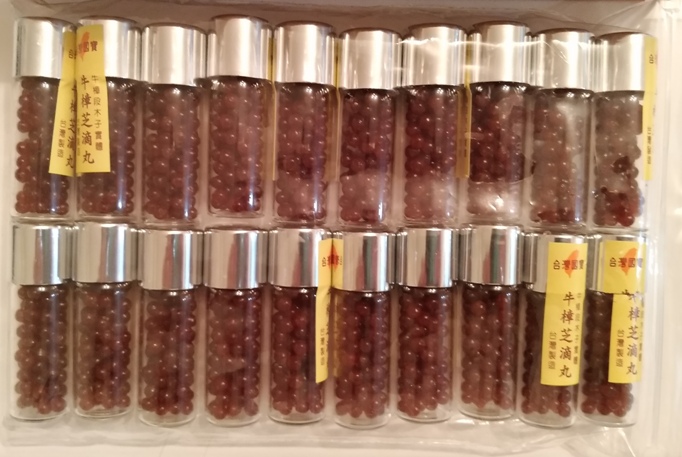
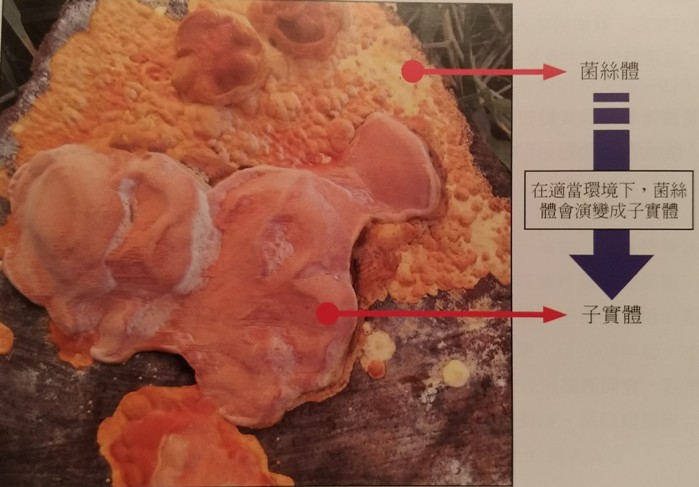
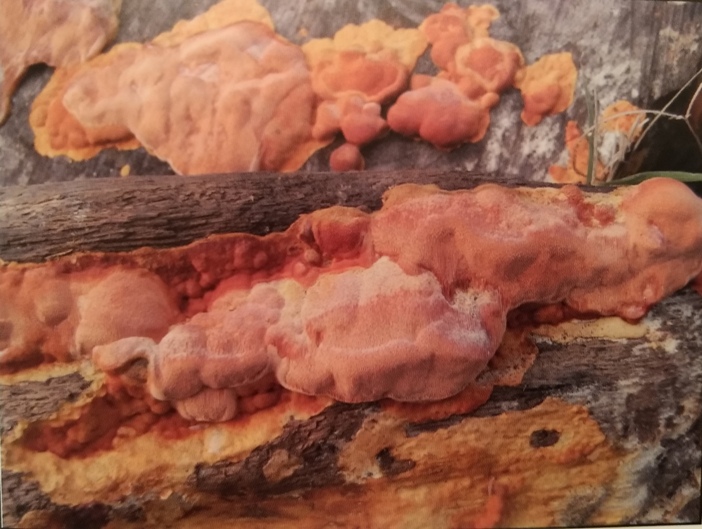
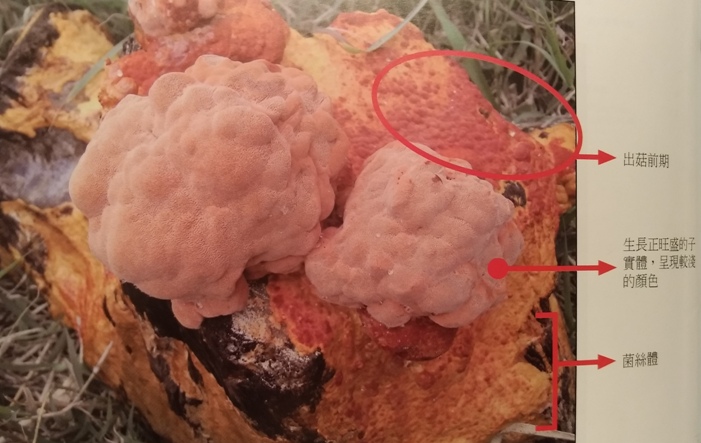
Order quantity


 You are Here: Home > Product > Bio-Tech products > AntroCina FD1 牛樟芝子實體滴丸FD1
You are Here: Home > Product > Bio-Tech products > AntroCina FD1 牛樟芝子實體滴丸FD1
 Back
Back


